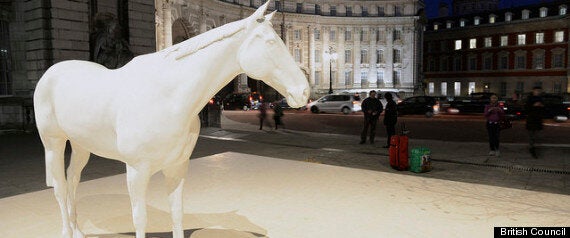An interesting social and artistic experiment has begun outside the British Council on The Mall in London. The artist Mark Wallinger has created a beautiful white horse - symbol of Olde Englande before it was even England (probably when it was Britannicus or just 'those pretty green isles' in Norse or French).
For the white horse carved out of chalk hills was as sacred to the inhabitants of these isles as the holy cow of India. Some say it's why we don't eat horses, although of course now we do.
If you visit the British Council's horse, you will be surprised that it (he, I think) stands on a low, oversized plinth. He is life-sized and perfectly realised (he was born in a scanner). No chains, ropes or signs to tell you what to do - or more importantly what not to do. And here's the rub...
Within an hour of his unveiling a scantily clad model in little more than a tan and a trench coat was draping herself over him for a photo. She was promptly chased away.

A few intrepid youths - international tourists by the looks of them - then mounted the plinth, but fortunately not the horse. They settled for patting him and stepping down. And then the questions began...
What if someone clambers on top and rides him? What if everyone mobs him? What if someone tags him with a black marker pen? What if someone scrawls 'Findus' on him? What if someone even comes in the dead of night and lifts him entirely and flogs the poor horse?
He scrubs clean, we have the original scan, but - and here's the social and artistic experiment - I don't think it matters what happens. Because whatever does will tell us something about the state of the nation, the state of society, the state of mind of an individual - and all that is in the compass of art.
I hope our horse is left to proudly stand. Gleaming white, proud and beautiful by day or night - when he is tastefully lit. There is grace and beauty in his honest yeoman stance.
My money is on kids on school trips being most likely to clamber on. Lots of teen hormones and showing off to do. I think the local street sleepers will leave him be, and they may even adopt him as theirs. He lives and sleeps in the same elements that they do.
A wag with a tired horsemeat joke is a reducing risk, but a graffiti tag is surely a near certainty. For my money we should leave whatever is done to him as a symbol and, if necessary, a reproach on the state of the nation.
If he's nicked we should leave his plinth empty for a while in quiet mourning. And then - like the one in Trafalgar Square - fill it with new art and inspiration.
We say the British Council Art Collection (which he has joined) is the 'museum without walls'. Our horse symbolises and embodies that.
Whatever happens will be to our collective credit or for our collective learning. Culture reflects society and art is the apex of culture. Let's hope for the best, but not fear the worst - art is for everyone and, like the British Council Collection, should be without walls.
